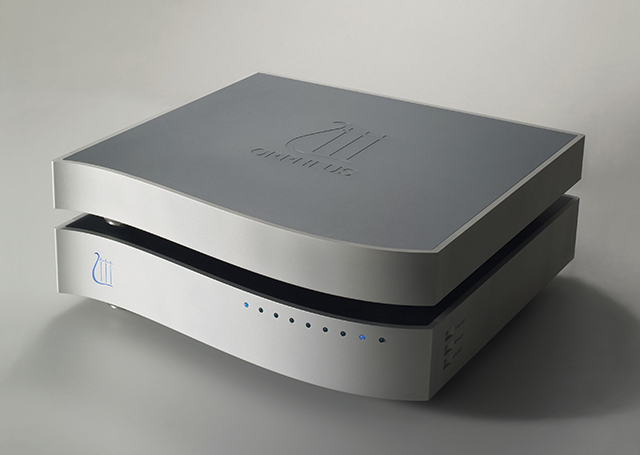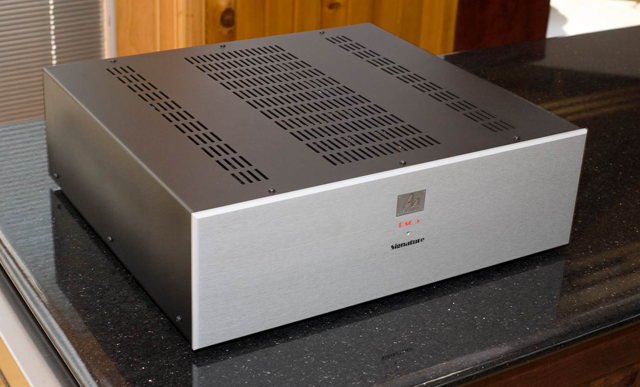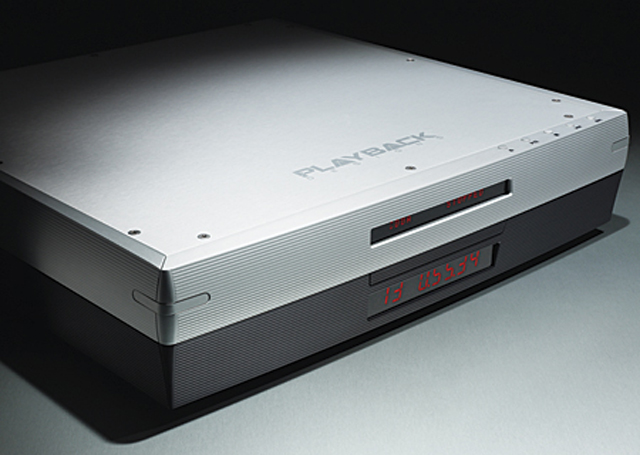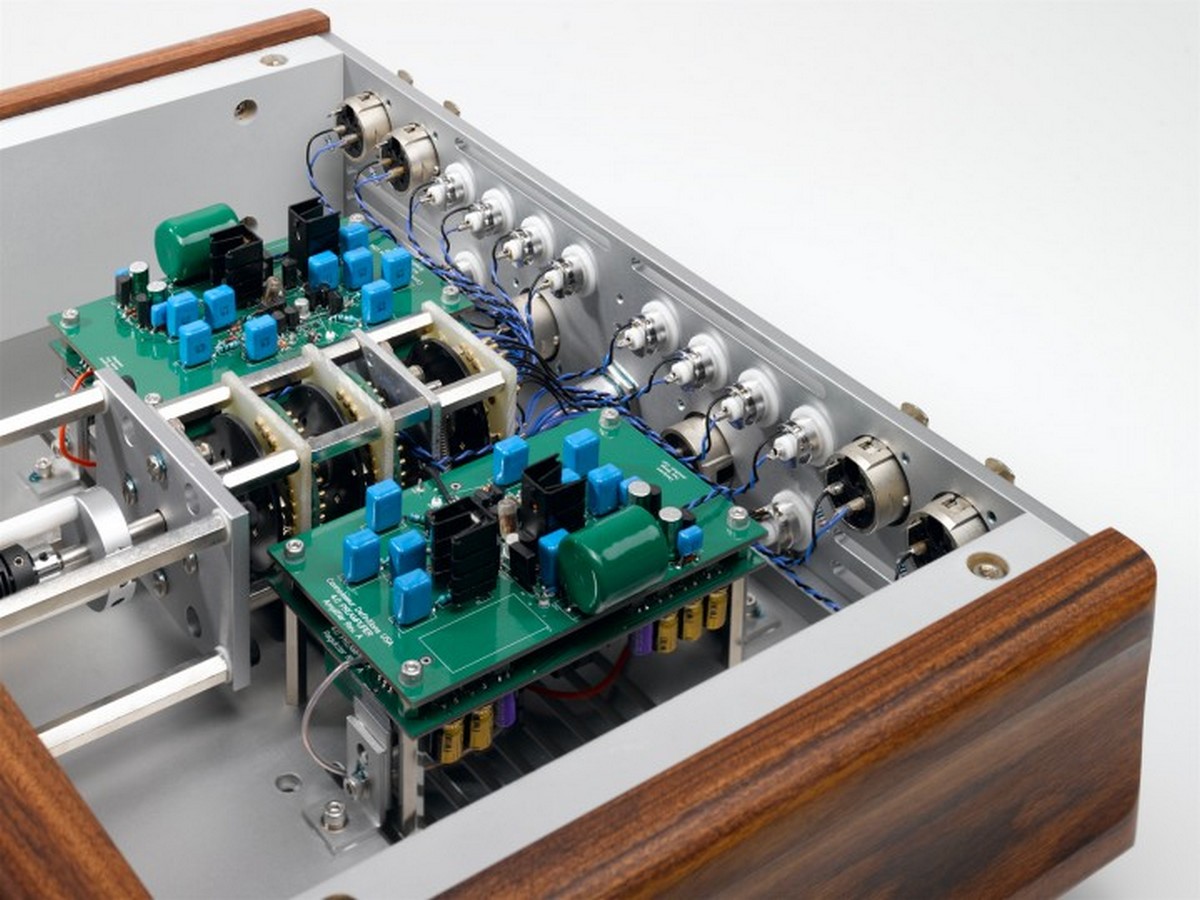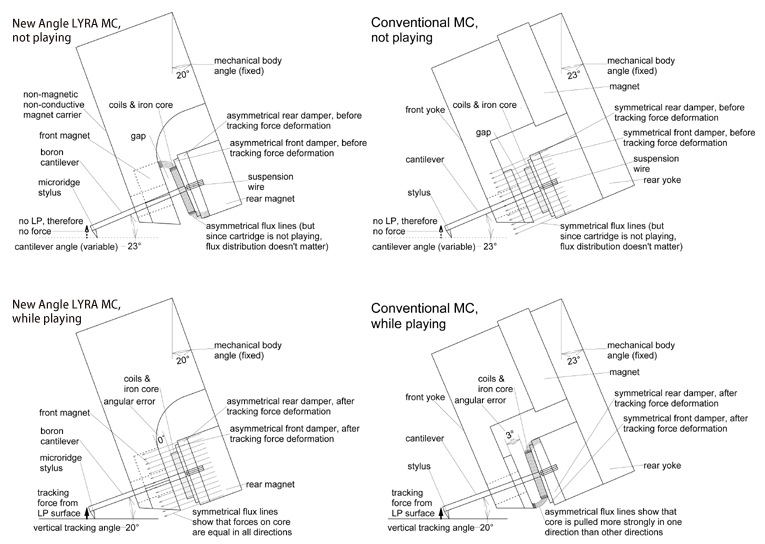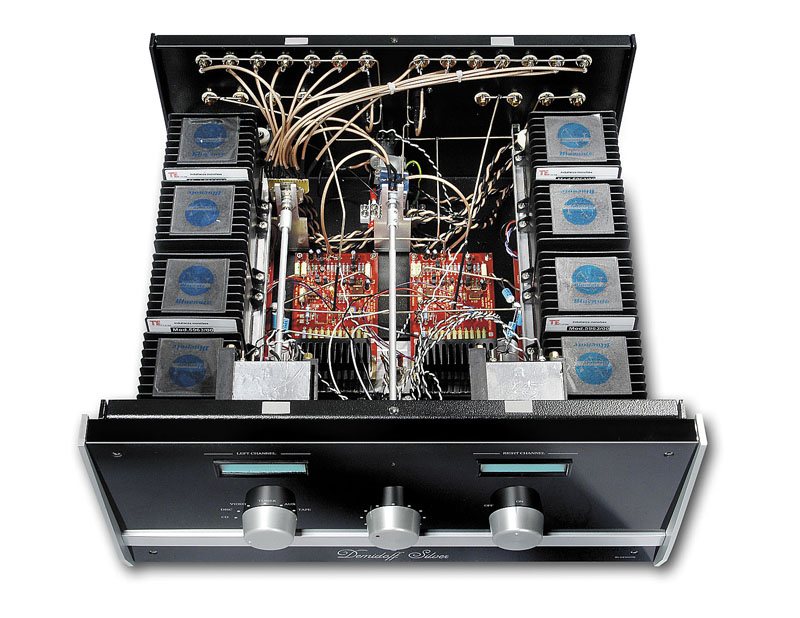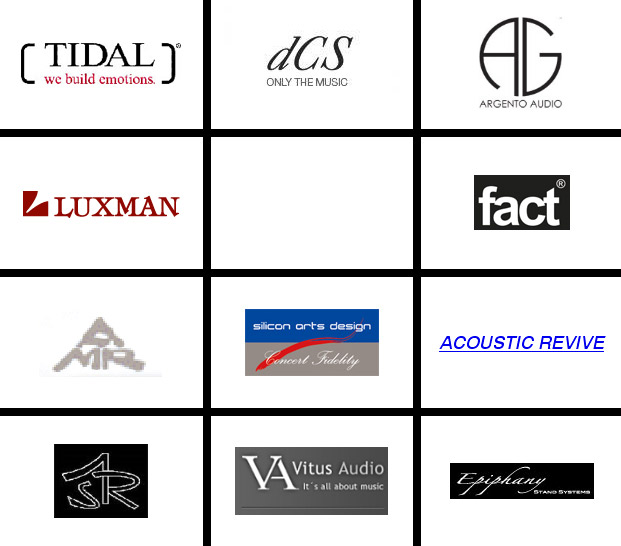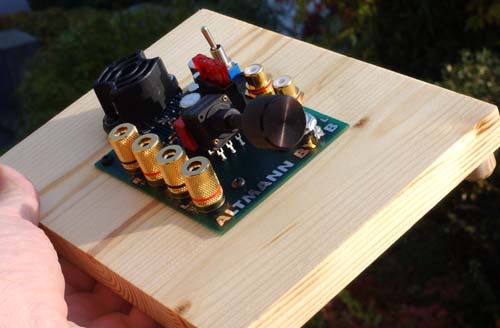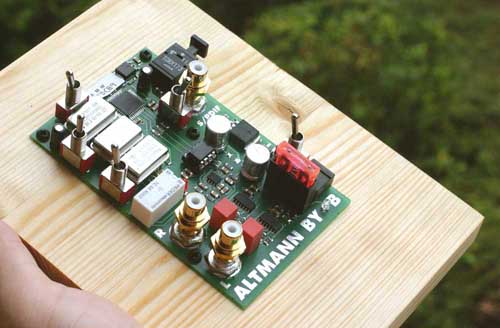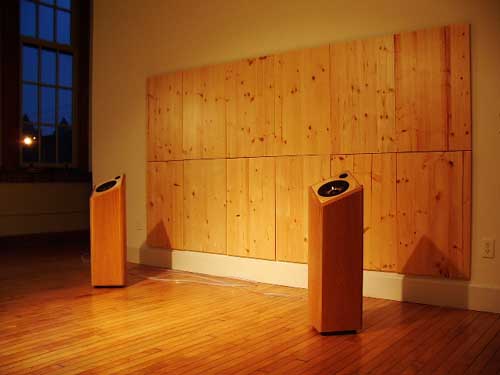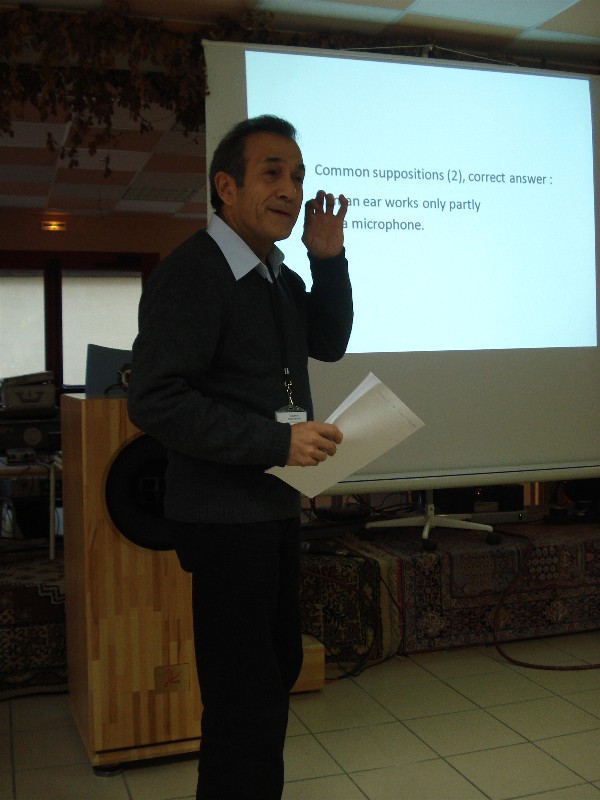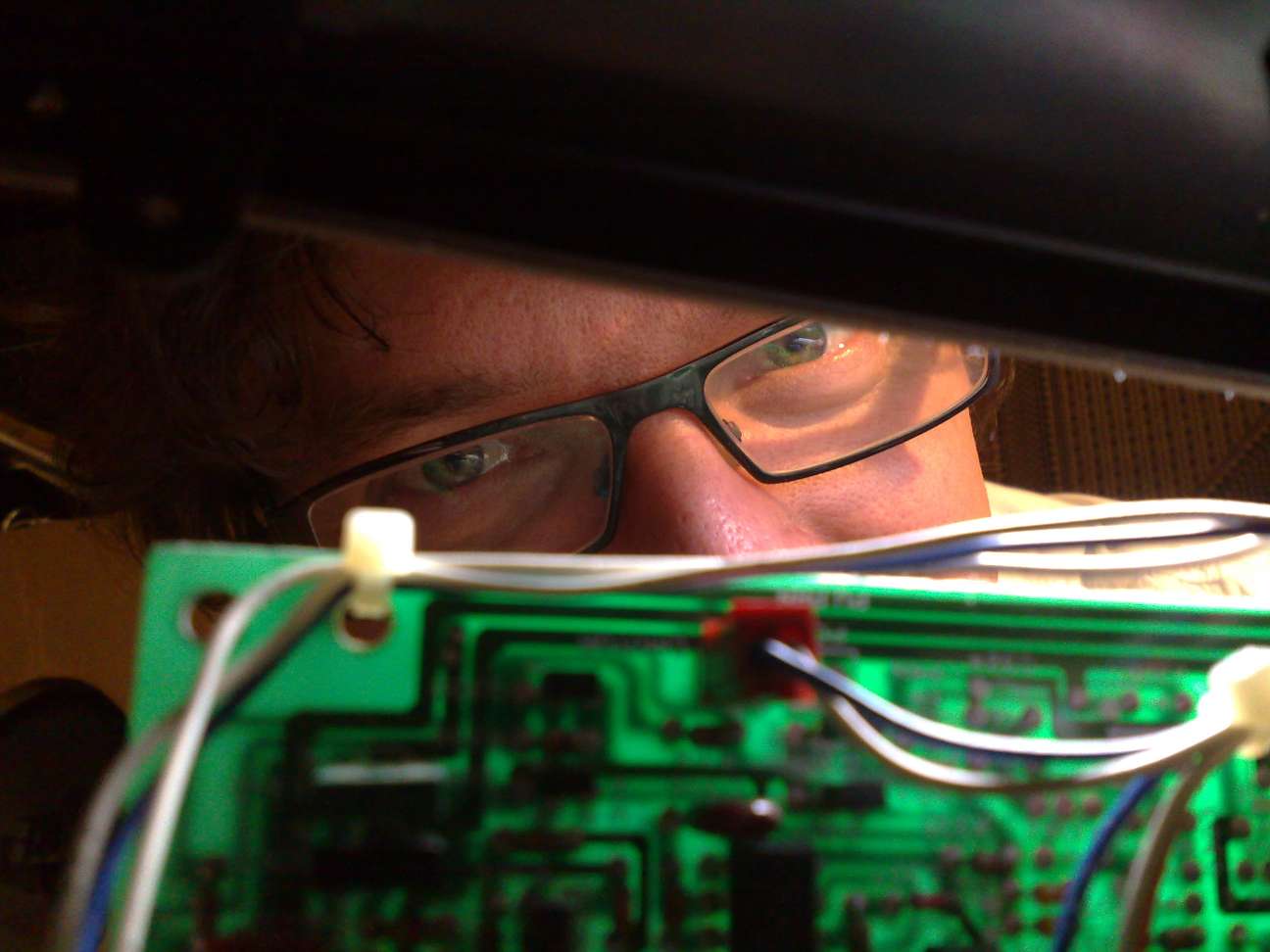http://www.sibatech.co.jp/abis/index.html
http://www.sibatech.co.jp/abis/Shugetsu%20tech%20for%20web.pdf
Idealized In The Digital Realm, Perfected In The Real World
Before we became acquainted with Tetsuo Kawanishi, former associate professor of the University of Electro-Communications Tokyo, we were unaware of the root cause of high frequency transient distortion in circuits employing negative feedback. Mr. Kawanishi’s work has revealed that this peculiar distortion is the result of modulation of high frequencies in circuits using (or misusing) negative feedback. The result of Mr. Kawanishi’s research is Shuhgetsu NRF (Negative Resistance Free) solid-state amplification technology. After extensive listening sessions using Mr. Kawanishi’s prototype amplifiers, and with numerous speaker types, we engaged him to design a completely new preamplifier and power amplifier. These new designs, the C-120 Stereo Preamplifier, and P-1120 Mono Block Power Amplifier, make use of Mr. Kawanishi’s patented circuits and years of research into the behavior of feedback amplifiers.
Good Sound Starts With a Good Circuit
No amount of expensive parts and careful tweaking can overcome the limitations of a poorly designed circuit. When we fully understood Mr. Kawanishi’s identification of the cause of bad sound from misapplied feedback, and his unique approach to perfecting feedback circuits, we knew that his designs would be an ideal platform for state-of-the-art audiophile components. Before talking about special quality parts, and build techniques, we want to share some technical insights about ‘negative resistance’ in a feedback amplifier.
Transient Distortion as caused by Negative Resistance:
What is ‘negative resistance’ and how harmfully is it to reproduced sounds?
Many solid-state amplifiers employ negative feedback to minimize high-frequency distortion. However, standard feedback does not work perfectly resulting in the erratic behavior of input and output impedance. The result is negative resistance. Such design flaws are present in emitter-follower and cathode-follower (as used in Marantz type equalizer) circuits.
Transient distortion may arise once this behavior occurs. Negative resistance tends to oscillate a circuit which destabilizes an amplifier’s operating point, causing the signal to be improperly amplified with transient distortion, which muddies the reproduced sound. When the circuit containing this negative resistance is exposed to high frequency noise (RFI, or switching power supply noises, for example), its operation is further destabilized, increasing transient distortion. In the old days of vacuum tubes, such high frequency noises seldom existed in audio reproduction. And even when the noise did occur, most tube amp designs employed a high frequency roll-off network at the point where the negative feedback was injected. This kept the amplifier from trying to reproduce frequencies outside the capabilities of the output transformer. The downside was “classic tube sound” and poor high frequency response.
But since the invention of semiconductors, the negative resistance issue is exacerbated by the transistor’s mass application in audio designs, and further compounded by the development of digital audio techniques. High frequency noises generated by electronic equipment has dramatically increased since the advent of switching power supplies, increased use of radio waves (cell phones) and the inclusion of digital circuitry in virtually every household device (ovens, toasters, etc..). Further, in negative feedback type amplifiers, high frequency noise will often be modulated by audio signals, causing further signals to be created as the result of the intermodulation of signal, HF noise, and “normal” distortion products (meaning distortion from active and passive parts; parts which deviate from the theoretically perfect device—all deviate from the idealized perfect part).
Measures taken in the Shuhgetsu circuits to cope with negative resistance:
In order to remove negative-resistance generated at the amplifier’s input stage, the designer has employed a patented circuit with carefully calculated values. Furthermore, in the feedback line which returns to the first stage of the amplifier, another patented circuit is inserted with differently calculated values to remove negative-resistance born in output impedance.
Herewith, NRF (negative resistance free) circuits are accomplished wherein the operating point is stabilized. Shuhgetsu amplifiers employ NRF circuits in voltage amplification and current amplification. Also, the regulated power supplies used by Shuhgetsu dramatically decreases transient distortion. The combination of carefully applied negative feedback, with low impedance power supplies allow the Shuhgetsu components to realize the potential of feedback, with none of the audible distortions which have given misapplied negative feedback a bad reputation.
Special attention given to power supplies:
Though an oversimplification, amplifiers modulate a power supply. If a power supply has high impedance at some frequencies, and low impedance at other frequencies, an amplifier might display deviations from a flat frequency response. Even worse, the amplifier may be driven to clipping at one frequency and not at others, and these distortions when added to the music can produce gross harmonic and intermodulation distortion.
Shuhgetsu amplifiers use fully regulated power supplies from the front-end voltage gain stages to the current amplifying output stages. The result is an amplifier with excellent damping, frequency response, and low distortion. No matter how good the signal circuit and parts quality, an amplifier must have an adequate power supply, or else the circuits and parts cannot perform their job.
The musical qualities of a regulated power supply:
* Powerful and tight bass in the P-1120 power amplifier. Thanks to use of regulated power supplies placed in all power amplification stages, which prevent voltage drop at significant power output, bass is clean, articulate and tonal. Unlike many tube amplifiers which have unregulated power supplied and limited reserves of power, there is no artificial warmth, no overhang, and no muddiness.
* Whereas power amplifiers generally use regulated power supplies only in the first voltage amplification stages, the Shuhgetsu P-1120 has stabilized power supplies throughout – all the way through to the power stage – unlike others. This fully regulated power supply is costly, but enriches bass reproduction by preventing voltage drops at high output.
* An ideal power supply has zero source impedance to prevent voltage drops, from DC to ultra high frequencies. The source impedance of the Shuhgetsu P-1120 amplifier is in the order of 0.01 ohm up to around 10KHz, and stays within 0.1 ohm above 10KHz due to special filtering and decoupling capacitors used in the power supply.
* An ideal power supply does not have high frequency noise from the AC line input, or generated by rectifiers. Because of carefully chosen transformers, rectifiers, resistors, and filtering capacitors, high frequency noise is shunted to ground before it can be injected into the signal.
* If the source impedance is high in a preamplifier, the sound becomes less powerful and clear. An ideal power supply should be regulated, having low impedance. So, the Shuhgetsu C-120 preamplifier uses the same principals as the P-1120 power amplifier. The supply for the C-120 preamp is the PS-120, which is housed in a separate chassis. By housing the power supply in a separate chassis, the delicate signals present in a preamplifier are fully protected from the various AC line noises and possible EM radiation from the transformer.
* The P-1120 power amplifier is built with a very large capacity EI core transformer, with excellent electromagnetic and electrostatic shielding to prevent this kind of noise from being radiated into the power amplifying circuits.
After a thoroughly engineered design comes careful tuning
After the design was completed to our satisfaction, it was finally time to do final tuning. Many high-end companies spend enormous amounts of time and energy covering up a bad circuit with good parts. With the Shuhgetsu, the parts are just as good, but happen to be in a superior circuit.
* Superior music reproduction is enhanced by the careful selection of circuit components which are chosen based on electrical characteristics. The electrical performance was scrutinized, and parts were chosen based on how close they came to the ideally perfect part.
* Resistors were chosen based on their linearity versus frequency. In other words, some resistors change value with frequency. The Shuhgetsu uses extremely linear resistors, chiefly from Nikkohm.
* Select power supply smoothing capacitors and low value (small capacitance) capacitors were chosen based a number of criteria, including ESR, frequency linearity, and lack of coloration in reproduced sound. This last judgment was based on listening tests, but was given as much importance as the electrical values. The quality of capacitors employed in the power supply has a major impact on the performance of the music amplifying circuits. As it has been said: garbage in, garbage out. The Shuhgetsu power supplies provide premium quality current to the signal stages. The capacitors employed include film types from Rifa and Rifa type 02 electrolytic smoothing caps.
* The Shuhgetsu products employ EMe (epitaxial mesa) power transistors and low noise SiE (SiEP) small signal transistors. These are ultra high performance transistors, carefully chosen for their high performance, are hand matched for minimum channel to channel variation and maximum reduction of distortion.
* TO-3 metal packaged power transistors were chosen for their minimal mechanical vibration and electromagnetic wave generation properties. This reduces intermodulation distortion (IM). Generally speaking, a power transistor generates imperceptible mechanical vibration by music signals, while also generating electromagnetic waves that vary with the music. This often impacts the input stage and causes intermodulation distortion.
Other Features and Considerations
* Differential Input Balanced Transmission Scheme
Balanced operation and connections are featured in both the C-120 preamplifier and P-1120 power amplifier. The benefits of balanced operation far outweigh the extra cost and difficulty in manufacturing. With common mode noise rejection, and low levels of hum, there are drastic improvements in dynamic scaling, localization, airiness, and spatial perspective. Further, the impact of cable quality is much less when using balanced connections. We do encourage purchasing cabling of impeccable build quality, but you will find less audible variation from brand to brand than when compared to single-ended connections. This is due to common mode noise rejection and the more robust nature of balanced operation. However, to make the most of your Shuhgetsu preamp and power amp, please consider the following:
* Because the wavelength of audio frequencies are sufficiently long compared to the length of wiring used in audio equipment, very little scientific investigation has been expended on the influence of cabling on audio signals. When we consider the influence of high frequency noise on an amplifier, it is quite important to emphasize cable matching in high frequency reproduction between an amplifier’s internal wiring and speaker cables. When there is an impedance mismatch, reflections at cable ends will occur, possibly causing an increase in high frequency noise. Shuhgetsu amplifiers are designed with countermeasures that assume a characteristic impedance of 75 ohms for line cables, and 120 ohms for speaker cables. We recommend use of cables specified by the Shuhgetsu designer.
* The cancellation of noise that is a benefit of balanced connection and operation is virtually impossible with single-ended connections. With single-ended connections, any noise induced through EMI or RFI on the connecting cables becomes part of the musical signal because there is no reference with which to compare the original signal. Only balanced connection can delete the problems of EMI and RFI through common-mode noise rejection.
* Further, it was found that balanced amplifiers heat up and stabilize much quicker than single-ended designs. Kawanishi’s unbalanced amplifiers would require at least 15 minutes of heating and stabilization for best sound. But the balanced versions of Kawanishi’s amplifiers sounded good almost immediately after powering up. In comparison to many power-hungry, single-ended designs, which must be left on for hours to stabilize, the Shuhgetsu won’t waste power or shorten your valuable listening time.
Some say that balanced design is a waste. Some say that it doesn’t sound as good. These opinions are based on poorly designed products. Balanced operation produces dramatic improvements, but requires bulkier and more expensive equipment because of the need to process two independent signals in one chassis. Put simply, a balanced design doubles everything of a single-ended design. It takes two duplicate circuits, working in tandem, to produce one balanced circuit. Other manufacturers of balanced amplifiers, with good specifications on paper only, have chosen to use cheap integrated circuit operational amplifiers for cost and space savings. Generally speaking, an IC op-amp is by nature a very high feedback device, and thus generates negative resistance that will muddy the sound. Understandably, this poor sound quality from cheaply built balanced products has lead listeners to conclude that an unbalanced type is actually better in sound. On the other hand, unbalanced amplification fosters listeners’ belief that the sound is better because there is a constant level of even order distortion, clouding the performance, and making the sound less precise. When they hear a poorly built balanced product that has very low noise and even order distortion, it serves to amplify the relative severity of the negative resistance and high order distortion caused by the IC op-amp, mediocre power supply or bad parts quality. Therefore, the Shuhgetsu products, which eschew the use of such IC op-amps is both theoretically and realistically superior in reproduction of natural sound by common mode noise removal.
Sturdy Housing and Provisions for Electromagnetic Wave
* The P-1120 Power Amplifier uses 5.6mm thick steel sheet for the chassis to secure internal components and suppress mechanical vibration at all points.
* Hospital-grade shielding of power transformer winding gaps, as used in medical equipment, guards against electromagnetic waves and noise which would cause common mode noise in the power supply. Without proper shielding, these spurious noises which occur in all transformers would in injected into the musical signal.
* Circuits and components have been carefully arranged to prevent the interaction of power supply circuits and amplification circuits. In very compact designs, there is coupling from one stage to another, causing IM distortion, spurious noise and instability. Components are arranged in the Shuhgetsu in a way that they aren’t being adversely affected by another component.
*The C-120 Preamplifier and PS-120 Power Supply use 3mm thick steel sheet to support the PC boards with a floating anti-vibration rubber mounting system.
* The separate power supply unit suppresses magnetic flux leakage to the preamplifier circuit.
* The same transformer shielding technology used in the power amplifier is used in the preamplifier power supply.
The fruit of our labors, the unique sound of Shuhgetsu
* Extraordinary amounts of detailed information, and low-level signal resolution, enable you to catch subtle point of sounds and to better appreciate and understand the music.
* No colorations assure you that you are experiencing the original sound from the musical instrument, as intended by the artist (not the equipment manufacturer).
* Highly accurate timbre keeps the relative levels of notes in proper placement, so notes do not improperly pop out of focus to impede upon listener engagement.
* No annoying peaks at high output levels from negative resistance. No aggressive sound or distortion at musical climaxes.
* Precise spatiality allows you to hear instrument placement quite clearly, and hear each instrument reproduced independently.
* Accurate phase produces wider listening area so you can better enjoy music off-axis of your speakers.
* Using regulated power supplies for all stages reproduces low frequencies with exceptional stability and clarity, and allows you to appreciate tonal scales of low-pitch instruments.
* The distinct airiness, openness and sound-staging reproduce the atmosphere of a live performance in your listening room.
* From the sound of a gentle stream, to a powerful ocean wave, Shuhgetsu can deliver massive changes in mood, timbre, scale, loudness, and all the other musical attributes that create the musical experience.
* Because of the low levels of noise and distortion, and highly accurate gain stages, the Shuhgetsu amplifier can, as a matter of course, reproduce acoustic instruments with a great degree of fidelity to overtones and detail. At the same time, any category of music can be enjoyed because of the power reserves and truthful character of Shuhgetsu.
* The bottom line is that by using patented circuits that avoid negative-resistance, power supplies that are quiet and low-impedance, parts that are very linear and noise-free, and chassis that rigidly hold components and circuits in an ideal spatial orientation, the sound is amplified with nothing added or taken away.
Abis Shuhgetsu: The genuine sound of musical instruments with no electronic distortion.
————————————————————————————————————–
Model C-120 Stereo Preamplifier (with PS-120 Power Supply Unit)
Model P-1120 Mono Block Power Amplifier
We were unaware of behaviors of modulated high audio frequency that resulted in uncomfortable transient distortion before we became acquainted with Tetsuo Kawanishi, former associate professor of the University of Electro-Communications Tokyo, and the designer of the Shuhgetsu NRF solid-state amplification technology. After exhaustive auditioning and investigation of Prof. Kawanishiʼs prototype amplifiers with different speakers, we asked him to design a combination of commercial equipment, preamplifier and power amplifier, as we were converted by his patented circuit design.
◎ Sonic Characteristics of Shuhgetsu Amplifiers
○ High-level of information density: Enables you to catch subtle point of sounds.
○ No coloration: Assures you an experience of the original sound from musical instrument.
○ Highly accurate timbral portrayal: The piano, horn, or soprano vocalization likely coming “Shuhgetsu” NRF Solid State Stereo System up at specific musical scales that does not irritate ears.
○ No annoying peaks at high output level: No looming aggressive sound and distortions.
○ Precise spatiality: You can see instrument placement quite clearly, and hear each instrument reproduced independently.
○ Accurate phase: Produces wide listening area so you can well enjoy music at any position off the speakerʼs front.
○ Full stages driven by stabilized power supply: Exceptionally stable reproduction of low frequency range that allows you to appreciate tonal scales of low-pitch instruments.
○ Quite distinct airiness and perspective of acoustic field: Reproduces the atmosphere of live performance in your listening room.
○ Sound unworldly like a limpid stream, and powerful like the ocean wave.
○ Depth of character: A Shuhgetsu Amplifier can as a matter of course reproduce acoustic instruments and any category of music.
◎ Genuine sound of musical instrument with no electronic distortions, employing patent applied circuit that deletes Transient Distortion caused by Negative Resistance.
● Transient Distortion caused by Negative Resistance
What is ‘negative resistance’ and how harmfully is it to reproduced sounds?
Solid-state amplifiers generally adopt ‘feedback’ circuitry to minimize high-frequency distortion, but it usually does not work perfectly resulting in possible degradation of real part
(pure resistance excluding inductance and capacitance) of each input and output impedance (usually complex number) into negative behavior, or negative resistance. Such deficit is
present in emitter-follower and cathode-follower (as used in Marantz type equalizer) circuits.
Transient distortion may arise once Negative Resistance is generated.:
Negative resistance tends to oscillate a circuit which destabilizes an amplifier’s operating point, causing music signal to be improperly amplified with transient distortion, which muddies the reproduced sound.
Infections of external noise:
When the circuit containing this negative resistance is exposed to external high frequency noise, its operation is increasingly destabilized with all the more transient distortion. In the
old days of vacuum tube, such high frequency noises seldom existed in audio reproduction.
But since the invention of semiconductors, the negative resistance issue is exacerbated with the transistorʼs mass application in audio designs, and further compounded with digital
technologies development. Infections of high frequency noises generated by electronic equipment has incomparably increased more than ever. (In a feedback type amplifier, high
frequency noise may also be modulated by audio signals.)
● What measures are taken in the Shuhgetsu amplifiers to cope with negative resistance? (2 patents applied)
In order to remove negative resistance generated in input impedance, the designer added a patented circuit with carefully calculated constant value in the input stage. Furthermore, in
the feedback line which returns to the first stage of the amplifier, another patented circuit is inserted with differently calculated constant value to infinitely remove negative resistance
born in output impedance.
Herewith, NRF (negative resistance free) circuit is accomplished wherein the operating point is stabilized. Shuhgetsu amplifiers employ NRF circuit in voltage amplification, power
amplification and stabilized power supply circuits to dramatically decrease transient distortion.
◎ Super High Fidelity music reproduction by use of carefully selected circuit components which are graded as close as possible to ideal elements.
● Theoretical values of high grade resistors and capacitors used in Shuhgetsu are about the same value in high frequency reproduction as in the following:
○ Resistors with minimum value variation regardless of frequency change.
○ Select electrolytic capacitors and low-capacitance capacitors for free of coloration in reproduced sound.
○ Block type electrolytic capacitors and film capacitors strictly selected for smoothing of ripple current and absorption of rectifying pulses in the power rectification circuit.
○ Adoption of EMe (epitaxial mesa) power transistors and low noise type SiE (SiEP) small signal transistors.
○ TO-3 metal package power transistors for their minimal mechanical vibration and electromagnetic wave generation properties, which reduces cross-modulation distortion.
(Generally, a power transistor generates imperceptible mechanical vibration by music signals, while also generating electromagnetic waves in parallel with the signals. This often impacts
input stage and causes cross-modulation distortion.)
◎ Balanced Connection adopted in both preamplifier C-120 and power amplifier P-1120 with positively deleted in-phase common mode noise and hum noise, for stabilized reproduced sound with drastic improvement in dynamic scaling, localization, airiness, and spatial perspective.
● Cable Matching:
Because the wavelength of audio frequency is sufficiently long compared to the length of wiring used in audio equipment, less attention has been paid to wiring affecting sound quality.
However, it is quite important to emphasize cable matching in high frequency reproduction between an amplifierʼs internal wiring and speaker cables when we consider the influence of
high frequency noise to an amplifier. When matching is not properly taken, reflections at cable ends will occur to cause possible increase of a particular bit of high frequency noise.
Shuhgetsu amplifiers are devised with countermeasures that assumed a characteristic impedance of 75 ohms for line cables and 120 ohms for speaker cable respectively. We
recommend use of cables specified by the Shuhgetsu designer.
● Balanced Connection:
In order to clear up these problems once for all, Shuhgetsu amplifiers employed Differential Input Balanced Transmission Scheme, wherein 3-line information transmission (phase
between hot and cold differs by 180 degrees) with a cold line added to ordinary two-line unbalanced transmission (hot and ground). This method enables cancellation of high
frequency noise riding on a signal line as in-phase element and delete to the utmost limit in order to depress transient distortion as much as possible. This is an effect impossible with
unbalanced system. Further merit is in heat-up time of the amplifier. The designer Kawanishi’s unbalanced type amplifiers used to require at least 15 minutes in heating up, but
balanced type enables quick music-listening right after the power is switched on with ideal sound quality.
● Does balanced connection produce bad sound?:
This balanced connection method produces dramatic improvements but may require more space and make the equipment bulky due to the need to process two independent signals in
one chassis. So some other miniature balanced type amplifiers with perfect specifications have adopted IC operational amplifiers for amplification stage to save space. Generally, an IC
operational amplifier is of high feedback nature and generates negative resistance that may muddy the sound, thus leading listeners to conclude that an unbalanced type is actually
better in sound. On the other hand, unbalanced amplification fosters listeners’ delusions that the sound is better because it becomes only partially aggressive when it comes under the
influence of high frequency noise. Therefore, Shuhgetsu balanced system without the use of such IC operational amplifiers is both theoretically and realistically superior in reproduction of
natural sound by common mode noise removal.
◎ Powerful and Sharp Bass in the P-1120 power amplifier, thanks to use of stabilized power supplies placed in all power amplification stages to prevent voltage drop at significant power output
● Whereas a power amplifier generally employs a stabilized power supply only in the front power amplification stage, Shuhgetsu P-1120 has stabilized power supplies throughout – up
to the power stage, unlike others. This full-stage stabilization is costly but enriches bass reproduction by depressing voltage drop at high output.
● An ideal power supply has zero source impedance to prevent voltage drop from DC to high frequency area, and does not have high frequency noise. Source impedance of Shuhgetsu
amplifier P-1120 is in the order of 0.01 ohm up to around 10KHz, and stays within 0.1 ohm even in higher (than 10KHz) frequency area due to special decoupling capacitors circuit in
the power supply.
● If the source impedance is high in a preamplifier, overall sound becomes less powerful and sharp. An ideal power supply should be a stabilized type having low impedance. So, Shuhgetsu preamplifier C-120 is also designed with this type of supply unit PS-120, which is housed in a separate chassis.
● P-1120 is built with a large capacity EI core transformer with excellent electromagnetic and electrostatic shielding to secure stable and clean power supply.
◎ Sturdy Housing and Provisions for Electromagnetic Wave
● Power Amplifier P-1120:
1) 5.6mm thick steel sheet for chassis to secure internal components and suppress mechanical vibration at all points.
2) Hospital-grade shielding for power transformer winding gaps, as used in medical equipment against electromagnetic wave and static electricity to block off common mode noise in the power supply.
3) Appropriately isolated stage placement to prevent interference between flux leaked from the power supply and electromagnetic wave generated in the amplification circuit.
● Preamplifier C-120 and Power Supply PS-120:
1) 3mm thick steel sheet as strong support structure for PC board unit, with vibration absorption rubber float system.
2) Separate power supply unit to suppress magnetic flux leakage to the preamplifier circuit.
3) Hospital-grade shielding for power transformer winding gaps, as used in medical equipment against electromagnetic wave and static electricity to block off common mode noise in the power supply.
Doc.abis20081218
Additional Technical Description
1. Circuit constant of the Shuhgetsu amplifier was determined not through monitoring scound quality, but by numeric calculation using a computer of a condition wherein negative resistance does no exist after having analyzed input and output impedances modelling on a single stage differential amplification with emitter-follower circuit.
Then the circuit constant is as straightly as possible applied in an actual circuit to determine a final circuit design. Thus, the Shuhgetsu circuitry was determined not by cut and try method but by using the values logically calculated as are. On the other hand, the elements chosen and used by monitoring sound are such parts as resistors and capacitors which are of high grade required to realize the determined circuit design as ideally as possible.
2. Key components used for the Shuhgetsu amplifier are as below:
A) EMe power transistors
B) SE capacitors for compensation
C) RIFA film capacitors as used for coupling or bypassing
D) RIFA Type 02 electrolytic capacitors
E) NIKKOHM plate type resistors
NONE of OFC parts including wires are being used.
3. Points taken care through sound monitoring to select required parts:
A) Much care was taken to enable to hear every note of the piano sound in any scale without deforming the sound image as well as the sound of collision occurring when the piano hammer is percussed. For example, there should not occur abnormal sound of a single note that suddenly brings pressure on the eardrums, and each note in tremolos should be clearly recognized.
B) Lift of soprano or alike vocal in a cetain interval should not abnormally give pressure on the eardrums.
C) Sound image of horn(s) should not deform otherwise distance perspective becomes hard to recognize.
D) The violins in a string concert should not be tightened or get clogged so that sound softness peculiar to strings as often heard in a concert house can be sensed.
E) A single note in piccicato part for contrabass should not unusually hollow in a room, and descending intervals can be clearly caught. (Such low pitched tone instruments as contrabass, bassdrum, timpani, or organ when simultaneously played can be cleanly heard.)
F) Finally, the Shuhgetsu should reproduce a concert hall presence in an audio listening room.
4. Shuhgetsu amplifier does not need a special listening room.
Conventional amplifiers had a problem in transient characteristics, so is much affected by a listening room, where listeners have to care much for curtains, rug or carpet, or other sound absorption material, but Shuhgetsu with super transient characteristics sets you free from sound absorption cares. In any type of room, Shuhgetsu sounds in its own way.
You also do not have to worry about the position to place a speaker system. Even if the speakers are roughly placed, more than a certain level of presence can be obtained. Its practical service area is quite wide allowing a listener with less knowledge about the acoustic field to command the Shuhgetsu. Ideally, the best is to place the speakers facing the front and listen at the vertex of an isosceles triangle. Further, it is suggested to give minimum 1 meter gap between the speakers and the wall behind.
Designer Tetsuo Kawanishi
Jan. 19, 2009
His following patents are employed in the Shuhgetsu:
No. 2118015 Collector type 2 stage feedback amplification (Dec. 6, 1996)
No. 2794667 Negative feedback amplification (June 26, 1998)
About the Output Circuit of P-1120 Power Amplifier
P-1120 output stage is ended with Complementary Parallel Push-Pull circuit. Designer Tetsuo Kawanishi explains why he adopted this circuitry as follows.
“As known widely, a transistor amplifier was born with semi-complementary push-pull circuit. Later a complementary circuit designs were developed little by little, and amplifier manufacturers began employing the complementary circuit except for a part of power IC, and majority of the manufacturers have followed one after another up to the present date.
Recently, production of power transistors suitable for audio use tend to be discontinued, so there are some manufacturers who went back to semi-complementary design. I am using complementary circuit for high end and semi- for less expensive products.
Parallel connection is adopted for the Shuhgetsu P-1120 to achieve high power output successfully without sacrificing audio quality as long as maximum two parallel stages.
This is the best choice to satisfy both of power output and sound quality. Many other manufacturers employ more than four parallels knowing that sound suffer demerits such as blur and lack in delicacy. Therefore, P-1120 can outstrip other higher output power amplifiers with 4 parallels. An example of the reports from my client is that Telos-200 sounds generally inferior to P-1120.”
April 4, 2009
Translation: M. Shibazaki, SIBATECH, Inc.
Read More

